NDVI stands for "Normalized Difference Vegetation Index". NRG stands for "Near-infrared / Red / Green". NDVI and NRG are both ways to visualize the amounts of infrared and other wavelengths of light reflected from vegetation. Because both these methods compare ratios of blue and red light absorbed versus green and IR light reflected, they can be used to evaluate the health of vegetation. It's a snapshot of how much photosynthesis is happening. This is helpful in assessing vegetative health or stress. (Read more here: https://www.agronomy.org/publications/jeq/articles/36/3/832) ## Do-It-Yourself These techniques for vegetation analysis were developed for satellite imagery, but at Public Lab, we've been working a lot on capturing infrared imagery using our DIY [near-infrared camera](/wiki/near-infrared-camera) setup, and combining it with visible bands to produce NDVI images such as the one above. ## What these images mean What exactly are these images we're trying to make? What do they tell us about vegetation, and why? These diagrams should help to understand what it is we're doing and why these are good ways to analyze plant life. ## The NDVI equation [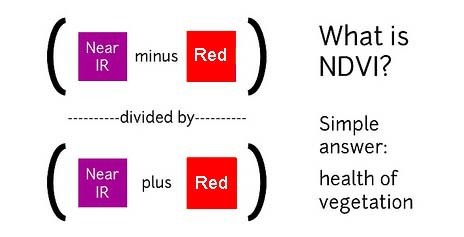](/i/44723) **NDVI = (Near Infrared - Red)/(Near Infrared + Red)** NDVI is a ratio which tries to emphasize photosynthesis while filtering out sun glare. The above equation is run for every pixel, using source data from an infrared photo and a visible light photo, like this pair: [](https://publiclab.org/system/images/photos/000/021/771/original/5390895115_c9d4d38fec_o.jpg) The result can be false-colored to make the high-photosynthesis areas more clear, and used to examine where plants are and how healthy they are. [](https://publiclab.org/system/images/photos/000/021/770/original/PetVISNDVIcomp.png) _Figure above: Normal color photo (right) and normalized difference vegetation index (NDVI) image (left). NDVI image was derived from two color channels in a single photo taken with a camera modified with a special infrared filter. Note that tree trunks, brown grass, and rocks have very low NDVI values because they are not photosynthetic. Healthy plants typically have NDVI values between 0.1 and 0.9. -- @cfastie_ ### Activities Here are a range of activities you can do to produce and interpret your own NDVI imagery, whether downloaded from a satellite imagery provider or [collected yourself using a DIY technique](/wiki/multispectral-imaging) [activities:ndvi] ****   Most DIY converted cameras today (those from Public Lab) use RGN instead of NRG, so the blue channel represents infrared instead of the red channel. That looks like this: [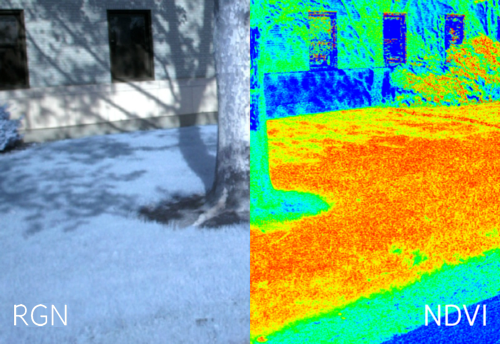](/i/45468?s=o) **** ## NRG imagery Some people are also interested in producing NRG imagery (like the below image), where `Near-Infrared, Red, and Green` are used to compose a picture instead of the usual `Red, Green, and Blue`. [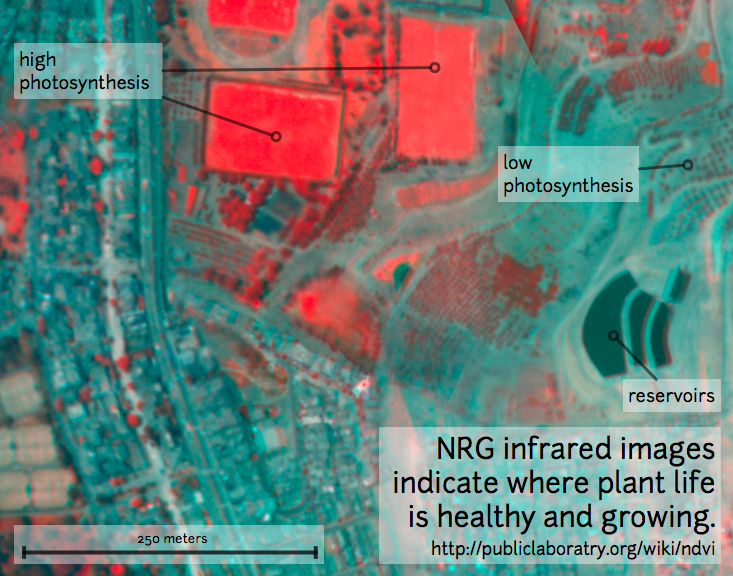](/i/25064) This diagram explains the swapping, which allows us to 'see' infrared as if it were a normal color: [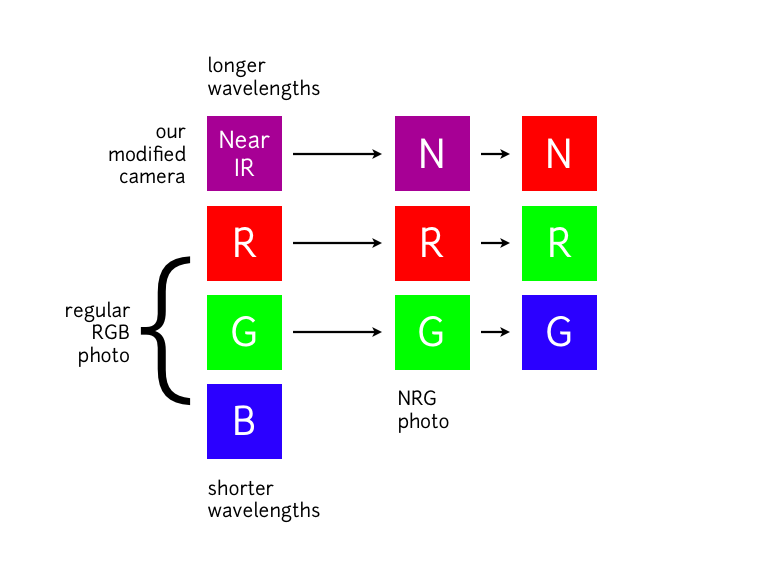](/i/25063) **In NRG images, the deeper and clearer the red color, the denser and healthier the vegetation (more or less).** ### Questions [questions:ndvi] ### Other examples of DIY NDVI imaging From around the internet: Begin watching at 2 minutes to see the resulting imagery: *This topic is part of the [Grassroots Mapping Curriculum](/wiki/mapping-curriculum) series.* **** [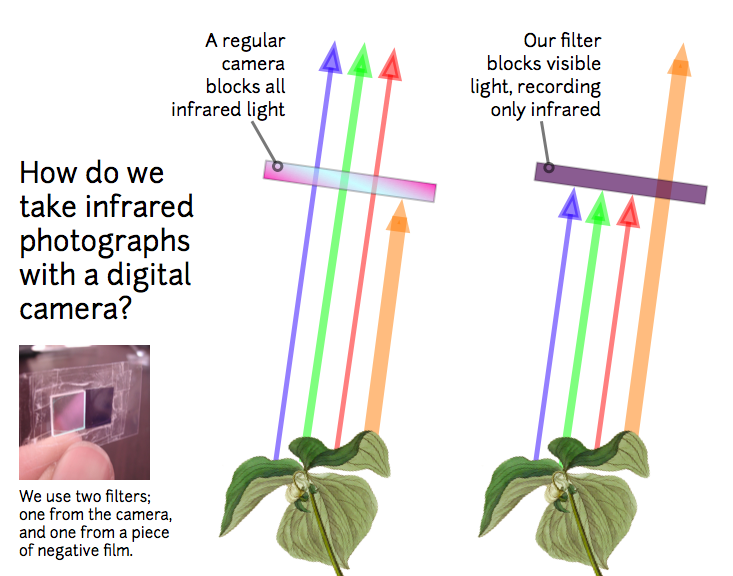](/i/25066) [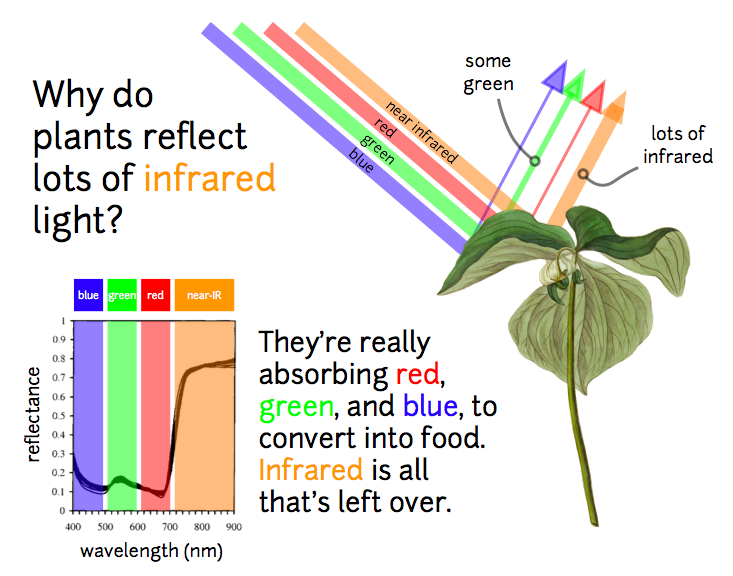](/i/25065) ...
| Author | Comment | Last activity | Moderation | ||
|---|---|---|---|---|---|
| csteran | "How will the processed image replace the current image?. Like how will this work better than the current image?. , and yes I think I will need a li..." | Read more » | almost 7 years ago | |||
| cfastie | "If you have a normal color photo and an NIR photo of the exact same scene, you can use the Photo Monitoring plugin for Fiji. The Github repository ..." | Read more » | almost 7 years ago | |||
| tech4gt | "@warren should i add this in documentation maybe add a section for raspi users complete with installation and setting up instructions ? " | Read more » | almost 7 years ago | |||
| warren | "Indeed! I think here it could be good to keep the original data in this case, maybe @csteran has a preference? But we should perhaps add steps and ..." | Read more » | almost 7 years ago | |||
| tech4gt | "@warren this gives me another idea, maybe we can add a replaceImage functionality in node as well (maybe as an extension to basic mode) which will ..." | Read more » | almost 7 years ago | |||
| tech4gt | "@warren this sound amazing, we can install the image-sequencer on raspi easily via npm and it would work nicely for this use case " | Read more » | almost 7 years ago | |||
| warren | "The default app raspicam can be used to take a picture from the commandline, and then you could use Image Sequencer to do the NDVI -- https://gith..." | Read more » | almost 7 years ago | |||
| csteran | "I need to do it without internet access, and we were thinking to use a photo command just like you said. Yes, I started learning phyton in order to..." | Read more » | almost 7 years ago | |||
| MaggPi | "It may be possible to use computer vision software (opencv) to directly manipulate the images on the PI computer. Check out https://publiclab.org..." | Read more » | almost 7 years ago | |||
| warren | "I'm thinking of if we could add a command from Image Sequencer (https://github.com/publiclab/image-sequencer) to the "take photo" command -- do you..." | Read more » | almost 7 years ago | |||
| warren | "This is one way to set up a Raspberry Pi to take photos remotely from a computer, using WiFi. It may not be exactly what you're looking for but the..." | Read more » | almost 7 years ago | |||
| warren | "Great question, @csteran -- just for a few clarifications, do you need to do it a) without internet access, or do you want to b) have it produce ND..." | Read more » | almost 7 years ago | |||
| warren | "Hi -- what is the pink picture? Is it from a modified camera, like an #infragram camera? Looks cool! " | Read more » | almost 7 years ago | |||
| liz | "HI everyone, @Davide_Ferrante is wondering how to make this picture that he took with a DJI Phantom 3 into a NDVI image. I guess the first thing th..." | Read more » | almost 7 years ago | |||
| warren | "Ah! https://publiclab.org/notes/cfastie/08-20-2013/white-balance-recovery Flashback! " | Read more » | almost 7 years ago | |||
| warren | "I guess to evaluate how well the 2x blue boost I posted above worked, we'd have to compare it to a better system, right? If other folks take a phot..." | Read more » | almost 7 years ago | |||
| cfastie | "I have tried several times to adjust the histogram of bad infrared photos. It has always failed and I don't know why. I assume it is because the ad..." | Read more » | almost 7 years ago | |||
| warren | "Hmm, could we manually multiply the blue channel by 2 or 3 to do a "post-processed white balance"? Of course this would need to be calibrated, but ..." | Read more » | almost 7 years ago | |||
| cfastie | "A single camera NDVI system with a red filter should produce a photo with very turquoise foliage. The blue channel (NIR) should be much brighter th..." | Read more » | almost 7 years ago | |||
| warren | "Incandescent white balance seems to work all right! But wait, here it is in NDVI using http://infragram.org -- black is zero NDVI, white is 1.0: ..." | Read more » | almost 7 years ago | |||
| RehmaanMalik | "Nice try Natalie Ui Developer @ RailsCarma & Carmatec " | Read more » | almost 7 years ago | |||
| warren | "@amanda and I did a take apart session and this is pretty easy to do with a good pair of pliers -- wire strippers worked well! " | Read more » | almost 7 years ago | |||
| jdburnett | "@dannysmith Your use of the ILS seems sound. Your work will certainly be more defensible if you can use Pagnutti' et. al's method, however, it may..." | Read more » | almost 7 years ago | |||
| nedhorning | "Setting up and running an integrating sphere is within your reach for a 12 week course as long as the equipment is working and you have access to s..." | Read more » | almost 7 years ago |